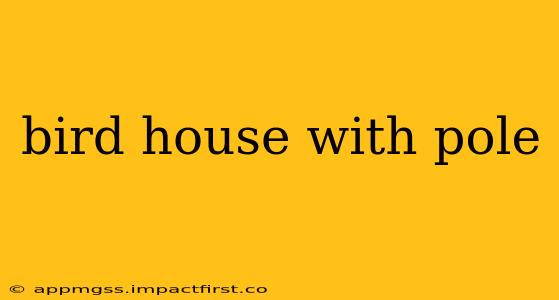Attracting feathered friends to your backyard is a rewarding experience. A birdhouse with a pole offers a safe and appealing haven, elevating the structure beyond reach of predators and providing a charming addition to your garden. This guide will walk you through everything you need to know about building and installing your own birdhouse with a pole, answering common questions along the way.
What are the benefits of a birdhouse on a pole?
A pole-mounted birdhouse offers several advantages over ground-level or tree-mounted options. Firstly, predator protection is significantly enhanced. Cats, raccoons, and snakes find it much more difficult to reach birds nestled safely aloft. Secondly, easier cleaning and maintenance are key benefits. Access to the birdhouse is simpler for annual cleaning, crucial for maintaining a healthy environment for the birds. Finally, a pole-mounted birdhouse provides a more aesthetically pleasing option, potentially enhancing your garden's visual appeal.
What kind of pole should I use for a birdhouse?
The best pole material for your birdhouse depends on your budget and aesthetic preferences. Metal poles are durable and weather-resistant, offering longevity. Wooden poles provide a more natural look, but require treatment to protect against rot and insect damage. Regardless of your choice, ensure the pole is sturdy enough to support the weight of the birdhouse and withstand various weather conditions. Consider a pole diameter of at least 2-3 inches for stability. The pole's height should be sufficient to deter predators, typically 4-6 feet above ground.
What type of birdhouse is best for a pole?
The ideal birdhouse design for a pole depends on the bird species you hope to attract. Researching the nesting preferences of local birds is essential. Small birdhouses are suitable for smaller birds like chickadees and wrens, while larger designs cater to larger species. Ensure the entrance hole size is appropriate for the target bird, as incorrect sizing can deter or attract unwanted species. Consider adding drainage holes to prevent water accumulation inside the house.
How do I attach a birdhouse to a pole?
Securing the birdhouse securely to the pole is crucial. Several methods exist, ranging from simple wire or zip ties to more robust mounting brackets. Metal brackets offer excellent stability and are weather-resistant. Ensure the chosen method prevents the birdhouse from swaying or twisting in windy conditions, safeguarding the birds inside. Properly spaced supports, if using wire, are key to distributing weight evenly and preventing damage to the birdhouse.
How high should I mount a birdhouse pole?
The ideal height depends on the species you are targeting and local predation risks. Generally, aiming for 4-6 feet above ground offers a good balance between predator deterrence and accessibility for the birds. However, taller mounting might be necessary in areas with significant predator activity. Consider the surrounding vegetation and structures when determining the optimal height. Placement should also take into account sunlight exposure and proximity to food and water sources.
How do I protect the pole from rot?
If using a wooden pole, protecting it from rot and insect damage is crucial for its longevity. Pressure-treated lumber offers inherent resistance, but applying a weatherproof sealant or paint provides added protection. Regular inspection and reapplication of sealant as needed will help maintain the pole’s condition and extend its lifespan. This preventative measure ensures the safety and longevity of your birdhouse and its avian inhabitants.
What kind of birdhouses attract the most birds?
This largely depends on your geographic location and the species present in your area. Researching native bird species and their nesting preferences is key. Providing various birdhouse styles and sizes increases the likelihood of attracting a wider range of species. Consider factors like materials, entrance hole size, and internal dimensions to maximize your chances of attracting different types of birds to your backyard. A little research will go a long way in crafting the perfect bird haven!
